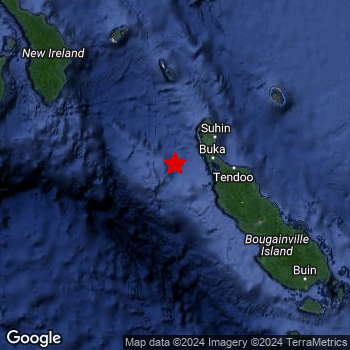A significant Magnitude 5.1 earthquake struck in the Solomon Sea 159 kilometer from Arawa, Papua New Guinea in the morning of Saturday May 4th, 2024.
Felt the earthquake? Share this article: 



Earthquake Summary
This earthquake hit under water in the Solomon Sea, 45 kilometers (28 mi) off the coast of Papua New Guinea, 159 kilometer west-northwest of Arawa in Bougainville. The center of this earthquake had an intermediate depth of 149 km.
| Date and Time: | May 4, 2024 09:47 (Bougainville Time) - May 3, 2024 22:47 Universal Time. |
|---|---|
| Location: | 159 km WNW of Arawa, Bougainville, Papua New Guinea. Coordinates 5°37'16"S 154°15'43"E. |
| Map: |  Map of area around epicenter. Click to open in Google Maps. |
| Magnitude: | MAG 5.1 Detected by 10 stations. Maximum Error Range ±0.098 . |
| Depth: | 149 km (92 mi) An intermediate depth. |
| Tsunami Risk: | Tsunami very unlikely Earthquakes under MAG-6.5 at depths deeper than 100km are very unlikely to cause tsunami's. Always stay cautious - More info here. |
Nearby towns and cities
This earthquake may have been felt in Papua New Guinea . Located 159 kilometer (99 mi) west-northwest of the epicenter of this earthquake, Arawa (Bougainville, Papua New Guinea) is the nearest significant population center.
Overview of nearby places
| Distance | Place |
|---|---|
| 159 km (99 mi) ESE from epicenter |
Arawa Bougainville, Papua New Guinea. |
| 263 km (163 mi) WNW from epicenter |
Kokopo East New Britain, Papua New Guinea. |
Risk of aftershocks?
We have not yet detected any foreshocks or aftershocks (MAG-2.5 or higher) within 100km (62 mi) of this earthquake.
Earthquakes can create aftershocks. These are generally at least 1 magnitude lower than any main shock, and as time passes the chance and strength of aftershocks decreases.
It's always adviced to be cautious of the risk of a larger shock following any significant earthquake, however this risk is fairly small. There is a roughly 94 percent change that no larger main shock will follow in the days following this earthquake.
Read: How to Stay Safe during an Earthquake (cdc.gov).Earthquakes like this happen often in the region
Earthquakes of this strength are very common in the region. This is the strongest earthquake to hit since April 15th, 2024, when a 5.4 magnitude earthquake hit 266 km (165 mi) further west. An even stronger magnitude 7.9 earthquake struck on January 22nd, 2017.
In total, 268 earthquakes with a magnitude of 5.1 or higher have been registered within 300km (186 mi) of this epicenter in the past 10 years. This comes down to an average of once every 14 days.
Tsunami very unlikely
For a serious tsunami to occur, earthquakes usually need to have a magnitude of at least 6.5 and occur at a shallow depth of maximum 100km. Neither are the case with this earthquake. However always stay cautious and monitor advice from local authorities.
Tsunami Risk Factors
| Factor | Under Sea? | MAG-6.5 or stronger? | Shallow depth? |
|---|---|---|---|
| Explanation | Almost all tsunami's are caused by earthquakes with their epicenter under sea or very near the sea. However stay cautious in coastal areas as earthquakes on land may cause landslides into sea, potentially still causing a local tsunami. | Under MAG 6.5: Very unlikely to cause a tsunami. MAG 6.5 to 7.5: Destructive tsunami's do occur, but are uncommon. Likely to observe small sea level changes. MAG 7.6+: Earthquakes with these magnitudes might produce destructive tsunami's. |
Most destructive tsunami's are caused by shallow earthquakes with a depth between 0 and 100km under the surface of the earth. Deeper tsunami's are unlikely to displace to ocean floor. |
| This Earthquake | This earthquake appears to have struck under the sea. | Not this earthquake. This earthquake had a magnitude of 5.1. Earthquakes of this strength are unlikely to trigger a tsunami. |
Not this earthquake. This earthquake occurred at a depth of 149 km (92 mi). Earthquakes this deep in the earth are unlikely to trigger a tsunami. |
Sources
Last updated 18/05/24 00:18 (). This article is automatically generated based on available data. We keep checking multiple sources for additional information. This article gets updated as new details on this earthquake become available.


